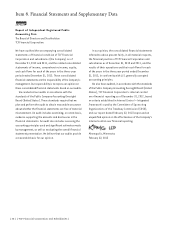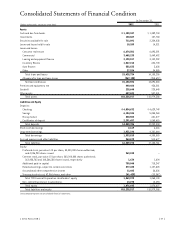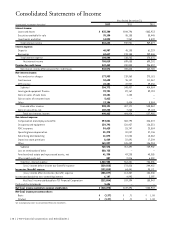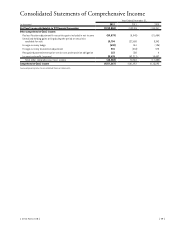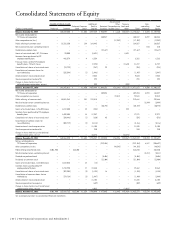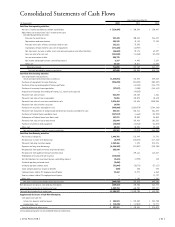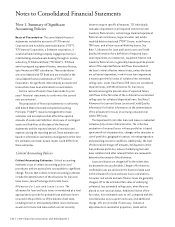TCF Bank 2012 Annual Report Download - page 82
Download and view the complete annual report
Please find page 82 of the 2012 TCF Bank annual report below. You can navigate through the pages in the report by either clicking on the pages listed below, or by using the keyword search tool below to find specific information within the annual report.estimated costs to sell, declines to less than the carrying
amount of the asset, the deficiency is recognized in the
period in which it becomes known and is included in other
non-interest expense. Operating expenses of properties and
recoveries on sales of other real estate owned are recorded
in foreclosed real estate and repossessed assets, net.
Operating revenue from foreclosed property is included
in other non-interest income. Other real estate owned
at December 31, 2012 and 2011 was $97 million and
$134.9 million, respectively. Repossessed and returned
assets at December 31, 2012 and 2011 were $3.5 million
and $4.8 million, respectively.
Investments in Affordable Housing Limited
Partnerships Investments in affordable housing consist
of investments in limited partnerships that operate
qualified affordable housing projects or that invest in
other limited partnerships formed to operate affordable
housing projects. TCF generally utilizes the effective yield
method to account for these investments with the tax
credits and amortization of the investment reflected in
the Consolidated Statements of Income as a reduction of
income tax expense. However, depending on circumstances,
the equity or cost methods may be utilized. The amount
of the investment along with any unfunded equity
contributions which are unconditional and legally binding
are recorded in other assets. A liability for the unfunded
equity contributions is recorded in other liabilities. At
December 31, 2012, TCF’s investments in affordable
housing limited partnerships were $15.8 million,
compared with $22.7 million at December 31, 2011.
Five of these investments in affordable housing
limited partnerships are considered variable interest
entities. These partnerships are not consolidated with
TCF. As of December 31, 2012 and 2011, the carrying
amount of these five investments was $15.2 million and
$22.1 million, respectively. The maximum exposure to loss
on these five investments was $15.2 million at December
31, 2012, however the general partner of these partnerships
provides various guarantees to TCF including guaranteed
minimum returns. These guarantees are backed by an
investment grade credit-rated company, which further
reduces the risk of loss. In addition to the guarantees,
the investments are supported by the performance of the
underlying real estate properties which also mitigates the
risk of loss.
Interest-Only Strips TCF periodically sells loans to
third-party financial institutions at fixed or variable rates.
For those transactions which achieve sale treatment, the
underlying loan is not recognized on TCF’s Consolidated
Statements of Financial Condition. The Company sells these
loans at par value and retains an interest in the future cash
flows of borrower loan payments, known as an interest-
only strip. The interest-only strip is recorded at fair value
at the time of sale. The fair value of the interest-only strip
represents the present value of future cash flows generated
by the loans, to be retained by TCF. After initial recording of
the interest-only strip, the accretable yield is measured as
the difference between the fair value and the present value
of cash flows expected to be collected. The accretable
yield is amortized into interest income over the life of the
interest-only strip using the effective yield method. The
expected cash flows are evaluated quarterly to determine if
they have changed from previous projections. If the present
value of the original cash flows expected to be collected is
less than the present value of the current estimate of cash
flows to be collected, the change is adjusted prospectively
over the remaining life of the interest-only strip. If the present
value of the original cash flows expected to be collected is
greater than the present value of the current estimate an
other than temporary impairment is generally recorded.
Intangible Assets All assets and liabilities acquired in
purchase acquisitions, including goodwill and other intan-
gibles, are recorded at fair value. Goodwill is recorded when
the purchase price of an acquisition is greater than the
fair value of net assets, including identifiable intangible
assets. Goodwill is not amortized, but assessed for impair-
ment on an annual basis at the reporting unit level, which
is one level below reportable operating segments. Interim
impairment analysis may be required if events occur or cir-
cumstances change that would more likely than not reduce
a reporting unit’s fair value below its carrying amount.
Other intangible assets are amortized on a straight-line or
effective yield basis over their estimated useful lives, and
are subject to impairment if events or circumstances indi-
cate a possible inability to realize their carrying amounts.
When testing for goodwill impairment, TCF may initially
perform a qualitative assessment. Based on the results
of this qualitative assessment, if TCF concludes it is more
likely than not that a reporting unit’s fair value is less than
its carrying amount, a quantitative analysis is performed.
TCF’s quantitative valuation methodologies primarily
include discounted cash flow analysis in determining fair
value of reporting units. If the fair value is less than the
carrying amount, additional analysis is required to measure
{ 66 } { TCF Financial Corporation and Subsidiaries }


